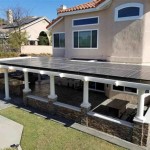How To Build A Free Standing Patio Roof
Constructing a free-standing patio roof is a rewarding project that enhances outdoor living spaces. It provides shade, protection from the elements, and a designated area for relaxation and entertainment. This guide offers a comprehensive overview of the steps involved in designing and building a durable and aesthetically pleasing free-standing patio roof.
Planning and Design Considerations
Before commencing any construction, meticulous planning is crucial. This stage involves determining the desired size and shape of the patio roof, selecting appropriate materials, and obtaining necessary permits. Ignoring this phase can lead to structural weaknesses and aesthetic mismatches.
The initial step involves measuring the area intended for coverage. This measurement informs the dimensions of the roof and dictates the quantity of materials required. Consider the purpose of the covered area. Will it primarily serve as a dining space, a lounging area, or a combination of both? The intended use will influence the design and placement of supporting posts. It is also vital to consider existing landscaping. Avoid obstructing walkways or important views.
Regarding design, the roof style warrants careful thought. Common choices include gable roofs, shed roofs, and flat roofs. Gable roofs, with their triangular shape, offer excellent water runoff and a classic aesthetic. Shed roofs, sloping in one direction, are simpler to construct and can be advantageous where directional sunlight control is desired. Flat roofs, while seemingly straightforward, require careful attention to proper drainage to prevent water accumulation and potential leaks.
Material selection significantly impacts the longevity and appearance of the patio roof. Pressure-treated lumber is essential for all structural components in contact with the ground or exposed to moisture. Common roofing materials include asphalt shingles, metal roofing, and polycarbonate panels. Asphalt shingles provide a cost-effective and widely available option, while metal roofing offers superior durability and a modern aesthetic. Polycarbonate panels offer translucence, allowing natural light to filter through while still providing shelter from rain and harsh sunlight. Choose materials that complement the existing architecture of the house and withstand the local climate conditions.
Furthermore, it is imperative to check local building codes and obtain the necessary permits before starting construction. Building codes vary by jurisdiction and ensure that the structure meets safety standards. Failure to comply with these regulations can result in fines and mandatory modifications.
Foundation and Post Installation
The foundation and post installation form the backbone of the patio roof. A stable and well-constructed foundation is vital for supporting the weight of the roof and withstanding wind loads. Improperly installed posts can lead to structural instability and potential collapse.
The first step involves marking the locations for each post. Ensure the spacing between posts is consistent and aligns with the planned dimensions of the roof. Dig holes for the footings below the frost line, the depth to which the ground freezes in winter. This prevents the foundation from heaving due to ground expansion and contraction.
Pour concrete into the footing holes, ensuring that the concrete is level and smooth. Before the concrete sets completely, embed post bases into the wet concrete. Post bases provide a secure anchor for the posts and prevent direct contact between the wood and the concrete, minimizing the risk of rot. Ensure the post bases are accurately aligned and plumb.
Once the concrete has fully cured, install the posts into the post bases. Use pressure-treated lumber for all posts, typically 6x6 or 8x8 inches in size, depending on the span and height of the roof. Secure the posts to the post bases using appropriate fasteners, such as lag bolts or structural screws. Plumb each post using a level and adjust as necessary to ensure verticality.
After the posts are securely in place, install temporary bracing to stabilize them. This bracing prevents the posts from shifting or leaning during the subsequent framing process. Diagonal braces attached to the posts at multiple points provide adequate support. Ensure the bracing is securely fastened to both the posts and the ground.
Framing and Roofing
The framing stage involves constructing the skeletal structure of the roof, providing support for the roofing material. Proper framing ensures the roof is structurally sound and capable of withstanding the elements. This step requires precision and attention to detail.
Begin by installing the beams that span between the posts. These beams form the primary load-bearing members of the roof. Use pressure-treated lumber, typically 2x8 or 2x10 inches in size, depending on the span and load requirements. Secure the beams to the posts using appropriate connectors, such as joist hangers or through-bolts. Ensure the beams are level and aligned with the posts.
Next, install the rafters that run perpendicular to the beams. Rafter spacing typically ranges from 16 to 24 inches on center, depending on the roofing material and local snow load requirements. Use pressure-treated lumber, typically 2x6 or 2x8 inches in size, for the rafters. Attach the rafters to the beams using appropriate connectors, such as rafter ties or toenailing. Ensure the rafters are evenly spaced and aligned.
For gable roofs, construct the gable ends using 2x4 or 2x6 lumber. The gable ends provide support for the roof sheathing and create the characteristic triangular shape of the gable roof. Ensure the gable ends are plumb and securely attached to the rafters and beams.
After the framing is complete, install roof sheathing over the rafters. Roof sheathing provides a solid surface for attaching the roofing material. Use plywood or oriented strand board (OSB) sheathing, typically ½ or ¾ inch thick. Secure the sheathing to the rafters using nails or screws. Ensure the sheathing is properly aligned and overlaps at the seams.
With the sheathing in place, install the chosen roofing material according to the manufacturer's instructions. Start by installing underlayment, such as roofing felt or synthetic underlayment, to provide an additional layer of protection against moisture. Overlap the underlayment at the seams to ensure a watertight seal. Then, install the roofing material, following the recommended fastening methods and overlap patterns. Ensure proper flashing is installed around chimneys, vents, and other penetrations to prevent water leaks.
Finishing Touches and Maintenance
The final stage involves adding finishing touches and establishing a routine maintenance schedule to ensure the longevity and beauty of the patio roof. Detailing such as trim, painting, and staining, greatly enhance the aesthetic appeal and blend the roof into the surrounding landscape.
Install trim along the edges of the roof to conceal the exposed sheathing and provide a finished look. Use pressure-treated lumber for the trim to withstand the elements. Secure the trim using nails or screws. Consider adding decorative elements, such as fascia boards or crown molding, to enhance the visual appeal of the roof.
Apply a sealant or stain to the wood surfaces to protect them from moisture and UV damage. Choose a sealant or stain that complements the color of the house and the surrounding landscape. Apply the sealant or stain according to the manufacturer's instructions, ensuring proper coverage and penetration. Regularly reapply the sealant or stain as needed to maintain the protective coating.
Inspect the patio roof regularly for signs of damage or wear. Check for loose shingles, cracked roofing, or decaying wood. Address any issues promptly to prevent further damage and maintain the structural integrity of the roof. Clean the roof periodically to remove debris, such as leaves, branches, and moss. Use a soft brush or broom to sweep away the debris. Avoid using high-pressure water, which can damage the roofing material.
By meticulously adhering to these guidelines, any homeowner can build a durable and aesthetically pleasing free-standing patio roof that provides years of enjoyment and enhances the outdoor living space.

Building A Patio Cover Plans For An Almost Free Standing Roof

Patio Roof Gazebo Construction Hometips Diy

How To Build A Freestanding Patio Cover With Best 10 Samples Ideas

Building A Patio Cover Plans For An Almost Free Standing Roof

How To Build A Freestanding Patio Cover With Best 10 Samples Ideas Homivi Covered Design Plans

Patio Cover Plans Wood S Creative Builders

6 Free Pergola Plans Plus Pavilions Patios And Arbors Building Strong

Building A Patio Cover Plans For An Almost Free Standing Roof

How To Build A Diy Covered Patio

Patio Cover Plans Wood S Creative Builders
Related Posts








